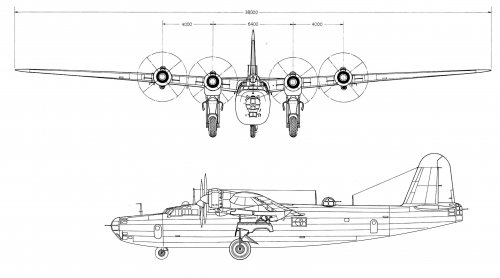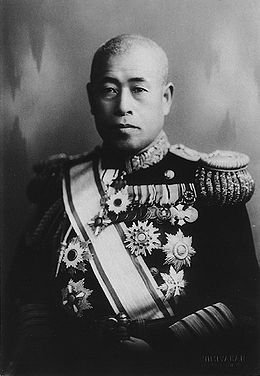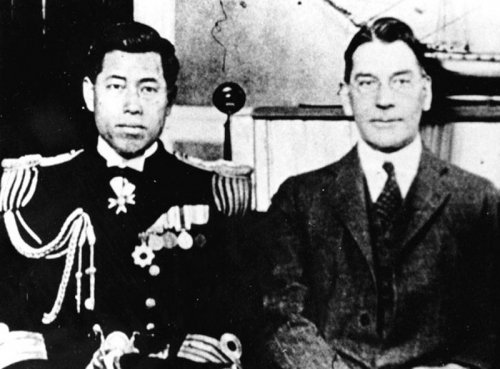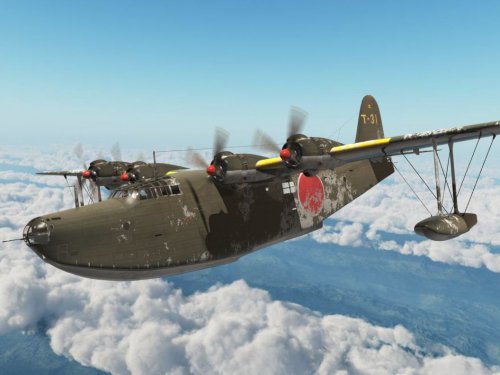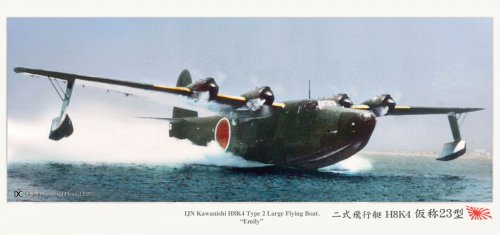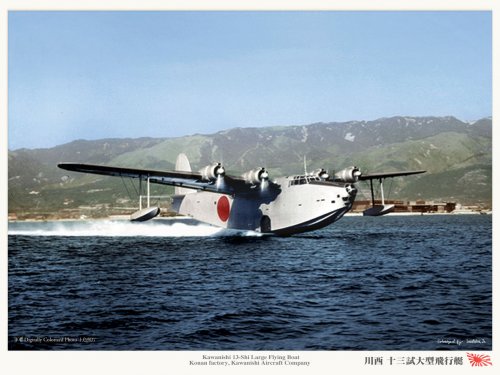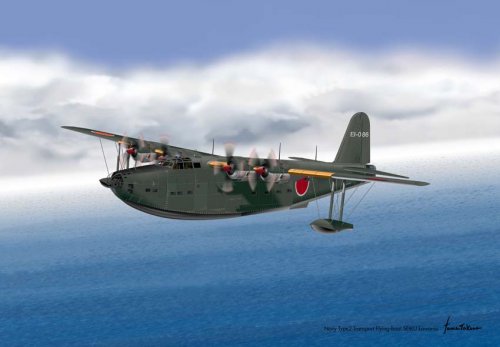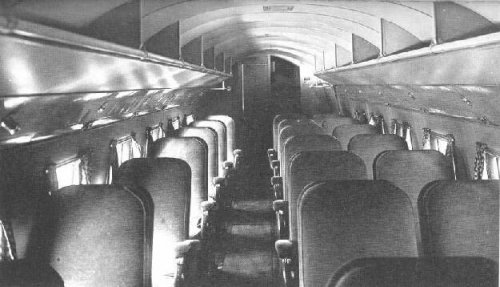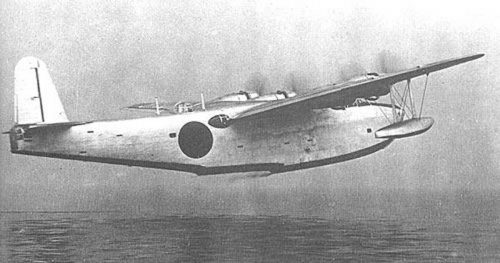You are using an out of date browser. It may not display this or other websites correctly.
You should upgrade or use an alternative browser.
You should upgrade or use an alternative browser.
Kawanishi's alleged "G9K Gunzan" (19-Shi Super Heavy Bomber)
- Thread starter Pelzig
- Start date
- Joined
- 25 June 2009
- Messages
- 13,769
- Reaction score
- 3,032
Hikoki1946 said:I firmly believe that the 19-shi Kawanishi bomber project is the G9K.
Never heard of this 19-shi (1944) bomber project, but of course the G9K designation (if real) would fit perfectly as it would be posterior to the G8M of 1943, contrary to the K-100 which was conceived in 1942...
Pelzig
ACCESS: Secret
- Joined
- 23 October 2008
- Messages
- 448
- Reaction score
- 65
Exactly. Makes no sense that the G9K would pre-date the G8N. I also think the 19-shi Kawanishi bomber is the same as the Kawanishi TB super heavy bomber. Robert C. Mikesh seems to think so as well.
Stargazer2006 said:Hikoki1946 said:I firmly believe that the 19-shi Kawanishi bomber project is the G9K.
Never heard of this 19-shi (1944) bomber project, but of course the G9K designation (if real) would fit perfectly as it would be posterior to the G8M of 1943, contrary to the K-100 which was conceived in 1942...
windswords
ACCESS: Secret
- Joined
- 19 May 2009
- Messages
- 387
- Reaction score
- 193
Does anyone have an image of this proposed G9K? Was it based on an existing Kawanishi aircraft (H6K, H8K)?
- Joined
- 26 May 2006
- Messages
- 32,676
- Reaction score
- 11,889
Who said about Kawanishi G9K,it was not real project,
it was a real attack bomber project,and it was for 17-Shi Specification,anybody
objects on aircraft or designation,must has the evidence,not by personal impression,
look to Wikipedia site;
http://en.wikipedia.org/wiki/Japanese_military_aircraft_designation_systems
it was a real attack bomber project,and it was for 17-Shi Specification,anybody
objects on aircraft or designation,must has the evidence,not by personal impression,
look to Wikipedia site;
http://en.wikipedia.org/wiki/Japanese_military_aircraft_designation_systems
- Joined
- 25 June 2009
- Messages
- 13,769
- Reaction score
- 3,032
hesham said:it was a real attack bomber project,and it was for 17-Shi Specification,anybody
objects on aircraft or designation,must has the evidence,not by personal impression,
look to Wikipedia site;
Who ever said Wikipedia was an indisputable source of truth?!?
It is NOT! It is written by all sorts of people who sometimes make mistakes.
hesham, you really ought to trust the authors and specialists on this forum more than Wikipedia...
Hikoki1946 knows A LOT more about Japanese aircraft than you and I put together!
In this particular case, G9M being the 17-Shi attack is pure BULL**IT.
If you know a little bit how the Japanese system worked, you'll know that:
[list type=decimal]
[*]the "-Shi" suffix indicated the year the aircraft was ordered (17-Shi means "1942")
[*]the number in the IJN designation was allocated in chronological sequence (G7* aircraft came before G8* aircraft, etc.)
[/list]What this indicates clearly is that a 17-Shi aircraft could NOT be G9-anything because the G8* competition came only in 1943!
G9N was necessarily a later proposal, hence Hikoki1946's suggestion it must have been the TB project.
- Joined
- 26 May 2006
- Messages
- 32,676
- Reaction score
- 11,889
Stargazer,
I have a book about Japanese aircraft,and I have some articles about Japanese
bombers,one of them has an Info about G9k,unfortunately I don't remember
it now,because it was between a more 1200 magazines of Aviation.
You forget to look at the reference of the site,they used the Info on a two
main books,and they are very trust references.
Third,there is many great sites confirm,that it was existed,such as;
http://www.globalsecurity.org/military/world/japan/ijnaf-aircraft-land.htm
I have a book about Japanese aircraft,and I have some articles about Japanese
bombers,one of them has an Info about G9k,unfortunately I don't remember
it now,because it was between a more 1200 magazines of Aviation.
You forget to look at the reference of the site,they used the Info on a two
main books,and they are very trust references.
Third,there is many great sites confirm,that it was existed,such as;
http://www.globalsecurity.org/military/world/japan/ijnaf-aircraft-land.htm
- Joined
- 25 June 2009
- Messages
- 13,769
- Reaction score
- 3,032
hesham said:Stargazer,
I have a book about Japanese aircraft,and I have some articles about Japanese
bombers,one of them has an Info about G9k,unfortunately I don't remember
it now,because it was between a more 1200 magazines of Aviation.
You forget to look at the reference of the site,they used the Info on a two
main books,and they are very trust references.
Third,there is many great sites confirm,that it was existed,such as;
http://www.globalsecurity.org/military/world/japan/ijnaf-aircraft-land.htm
Books can be wrong. Authors can be wrong. I have found countless mistakes in many books by supposedly reliable authors...
Western authors with little knowledge of the Japanese system have made mistakes and these mistakes got repeated over the years, time and time again.
The fact that GlobalSecurity.org says something doesn't make it true. Even Jane's, once the world's leading authority, has made mistakes in the past. Besides I hardly consider GlobalSecurity a highly valuable reference. Very often they copy-paste material they pick elsewhere.
No-one knows Japanese aircraft better than the Japanese themselves. And when you find no solid evidence of something in any of their books or websites, then it is more than likely that it doesn't exist! What I wrote in my previous post is entirely logical and can be verified. An aircraft designed for a 1942 specification could NOT be designated G9_. 1942 spawned NO "G" competition at all. G7_ was 1941, G8_ was 1943. However, there were two "J" competitions in 1942, one that brought about the J3K Jinpu, and the other the J4M Senden. And if you look at what the K-100 aircraft looked like, its size and its mission, it was more likely a J-type than a G-type. Perhaps the K-100 competed against the J4M? In that case it *could* have been called the J4K, but that is only speculation on my part.
Pelzig
ACCESS: Secret
- Joined
- 23 October 2008
- Messages
- 448
- Reaction score
- 65
Rene Francillon's book, while likely one of the better discourses on Japanese aircraft in English, came out in 1970. My copy is a 1988 reprint...not a revision. So, his text hasn't changed since the book came out. Yes, Francillon has the G9K as a 17-shi bomber project. I firmly believe that he is mistaken. In his own text on the G8N, he includes the K-100 in discussing the competition between it and the G7M and the cancellation of both projects. The K-100 was canceled so fast, it never would have received a designation like G9K. The only mention in his book is in the back under the "shi" listings.
In the July 1981 issue of "Airpower" magazine, Robert C. Mikesh speaks of the late war, big bomber projects. In it, he lists the 19-shi Kawanishi super heavy bomber project, citing it as the TB. Francillon mentions no 19-shi bomber project. Mikesh also feels this 19-shi bomber may be the Gunzan, which has been associated with the G9K designation.
Now, we know that the G10N designation was never applied by the Japanese to the Fugaku bomber project. It was a post-war designation given to it based on the naming convention and for ease of identification by various authors. Therefore, the G9K may be completely fictional, a made up post-war designation to identify the Gunzan bomber project. He also states that the Fugaku was Nakajima's answer to the 19-shi specification.
What is certain is that the K-100 has been clearly established as a twin-engine bomber, a 17-shi project, in competition with the Mitsubishi G7M, by sources today.
As I think about it, I'm falling into the notion that the G9K designation is, in fact, made up, just like the G10N designation was. Kawanishi called their project TB internally and likely gave it the Gunzan name in keeping with the naming of bombers after mountain themes, just like Nakajima only called their bomber project(s) Fugaku.
In the July 1981 issue of "Airpower" magazine, Robert C. Mikesh speaks of the late war, big bomber projects. In it, he lists the 19-shi Kawanishi super heavy bomber project, citing it as the TB. Francillon mentions no 19-shi bomber project. Mikesh also feels this 19-shi bomber may be the Gunzan, which has been associated with the G9K designation.
Now, we know that the G10N designation was never applied by the Japanese to the Fugaku bomber project. It was a post-war designation given to it based on the naming convention and for ease of identification by various authors. Therefore, the G9K may be completely fictional, a made up post-war designation to identify the Gunzan bomber project. He also states that the Fugaku was Nakajima's answer to the 19-shi specification.
What is certain is that the K-100 has been clearly established as a twin-engine bomber, a 17-shi project, in competition with the Mitsubishi G7M, by sources today.
As I think about it, I'm falling into the notion that the G9K designation is, in fact, made up, just like the G10N designation was. Kawanishi called their project TB internally and likely gave it the Gunzan name in keeping with the naming of bombers after mountain themes, just like Nakajima only called their bomber project(s) Fugaku.
- Joined
- 26 May 2006
- Messages
- 32,676
- Reaction score
- 11,889
All we can be wrong,
but no one evidence for that designation was never existed,even in the Japanese
sites,you will find; Kawanishi G9K was a bomber project,if we can't trust in books
and magazines,why we read it.
but no one evidence for that designation was never existed,even in the Japanese
sites,you will find; Kawanishi G9K was a bomber project,if we can't trust in books
and magazines,why we read it.
Pelzig
ACCESS: Secret
- Joined
- 23 October 2008
- Messages
- 448
- Reaction score
- 65
"Trust but verify."
I don't think we are debating that the G9K was a bomber project. What we are debating is the designation. A lot of the Japanese sources I have do not use "G10N" because it never existed in wartime Japanese documents concerning the Fugaku. There is so much confusion about the "G9K" designation that if it isn't mentioned in Japanese sources, then somebody, postwar, started using it and it stuck.
To throw gasoline on the flames, the Kawanishi TB bomber had the internal Kawanishi designation KX-9. Now we have a case of mistaken designation? I'm hedging my bets it is.
And to add, the KX-9 (TB) was not Navy but Army. Hmm!
I don't think we are debating that the G9K was a bomber project. What we are debating is the designation. A lot of the Japanese sources I have do not use "G10N" because it never existed in wartime Japanese documents concerning the Fugaku. There is so much confusion about the "G9K" designation that if it isn't mentioned in Japanese sources, then somebody, postwar, started using it and it stuck.
To throw gasoline on the flames, the Kawanishi TB bomber had the internal Kawanishi designation KX-9. Now we have a case of mistaken designation? I'm hedging my bets it is.
And to add, the KX-9 (TB) was not Navy but Army. Hmm!
hesham said:All we can be wrong,
but no one evidence for that designation was never existed,even in the Japanese
sites,you will find; Kawanishi G9K was a bomber project,if we can't trust in books
and magazines,why we read it.
Pelzig
ACCESS: Secret
- Joined
- 23 October 2008
- Messages
- 448
- Reaction score
- 65
The Kawanishi K-120 topic moved off into a good debate on the existence of the Kawanishi G9K but since this had no relation to the K-120 thread, I felt it was prudent to make a new topic to continue this discussion.
So, I'll try to re-cap my thoughts on the G9K. No Japanese source I've read or heard of mentions the G9K. It was mentioned in 1970 in Rene Francillon's tome on Japanese aircraft, in the back, as a 17-shi bomber project. But he gives no details outside of calling it a "project." Some people make the assumption that the Kawanishi 17-shi bomber project, the K-100, was the G9K. I contend this is false. The K-100 was the only competitor to Mitsubishi's 16-shi bomber, the G7M. While the G7M went through numerous revisions, the K-100 did not and the K-100 was almost immediately rejected (along with the G7M). Thus, the IJN wouldn't have given the K-100 the G9K designation. In addition, having a G9K before the Nakajima G8N bomber would break the IJN's naming convention. We know that the G10N designation for the Nakajima Fugaku was not ever used by the Japanese during the war to designate the Fugaku. It was created post-WW2 for convenience, based on the naming convention for bombers.
In a 1981 magazine article on Japanese heavy bombers, respected Japanese aircraft historian Robert C. Mikesh makes no mention of the G9K. Instead, he discusses the Kawanishi 19-shi elliptical winged bomber, calling it the TB, and he felt this might be the Gunzan. The G9K has often been cited as the Gunzan. But again, Mikesh does not identify what he thinks the Gunzan might be as the G9K.
Now, there is the possibility that the G9K designation was a misreading of Kawanishi's TB bomber project. Internally, Kawanishi called the TB the KX-9. If, in fact, it was a misreading, then the G9K is clearly a fictional designation.
Now, along comes another quandary. In Minoru Akimoto's 2008 published All the Experimental Aircraft in Japanese Army, he lists the TB as a IJA project and the illustration is not a elliptical winged design. So, now we have two Kawanishi heavy bombers, the TB and the 19-shi. Which begs the question on if the elliptical winged 19-shi bomber is a misidentified Fugaku design and not associated with Kawanishi at all. And to add, Kawanishi was exclusively a Navy contracted aircraft manufacturer...so what are they doing working on a Army project?
So, I'll try to re-cap my thoughts on the G9K. No Japanese source I've read or heard of mentions the G9K. It was mentioned in 1970 in Rene Francillon's tome on Japanese aircraft, in the back, as a 17-shi bomber project. But he gives no details outside of calling it a "project." Some people make the assumption that the Kawanishi 17-shi bomber project, the K-100, was the G9K. I contend this is false. The K-100 was the only competitor to Mitsubishi's 16-shi bomber, the G7M. While the G7M went through numerous revisions, the K-100 did not and the K-100 was almost immediately rejected (along with the G7M). Thus, the IJN wouldn't have given the K-100 the G9K designation. In addition, having a G9K before the Nakajima G8N bomber would break the IJN's naming convention. We know that the G10N designation for the Nakajima Fugaku was not ever used by the Japanese during the war to designate the Fugaku. It was created post-WW2 for convenience, based on the naming convention for bombers.
In a 1981 magazine article on Japanese heavy bombers, respected Japanese aircraft historian Robert C. Mikesh makes no mention of the G9K. Instead, he discusses the Kawanishi 19-shi elliptical winged bomber, calling it the TB, and he felt this might be the Gunzan. The G9K has often been cited as the Gunzan. But again, Mikesh does not identify what he thinks the Gunzan might be as the G9K.
Now, there is the possibility that the G9K designation was a misreading of Kawanishi's TB bomber project. Internally, Kawanishi called the TB the KX-9. If, in fact, it was a misreading, then the G9K is clearly a fictional designation.
Now, along comes another quandary. In Minoru Akimoto's 2008 published All the Experimental Aircraft in Japanese Army, he lists the TB as a IJA project and the illustration is not a elliptical winged design. So, now we have two Kawanishi heavy bombers, the TB and the 19-shi. Which begs the question on if the elliptical winged 19-shi bomber is a misidentified Fugaku design and not associated with Kawanishi at all. And to add, Kawanishi was exclusively a Navy contracted aircraft manufacturer...so what are they doing working on a Army project?
According to a Japanese correspondent who wrote me ,the sideview of the eleptical wingend bomber
in the R.C Mikesh article ,was part of a three view which appeared in a Japanese magazine in 1965.
It should have been pure speculation...
in the R.C Mikesh article ,was part of a three view which appeared in a Japanese magazine in 1965.
It should have been pure speculation...
- Joined
- 25 June 2009
- Messages
- 13,769
- Reaction score
- 3,032
Hikoki1946 said:I was flipping through Aireview's Japanese Navy Aircraft in the Pacific War (1972) and in their aircraft listing, they do not list a G9K or any such designation.
... hence the quotes on either side of the designation in the topic's title... :
blackkite
Don't laugh, don't cry, don't even curse, but.....
- Joined
- 31 May 2007
- Messages
- 8,297
- Reaction score
- 5,892
Hi! From Japanese wikipedia.
二式大艇開発後、川西では次の機体開発について3案があり、強風を陸上機化した戦闘機開発、新型艦上攻撃機開発案、本機を陸上機化した爆撃機の開発案で、海軍でG9Kの記号を与えられたが結局戦闘機開発が優先された為に中止された。
After 2-shiki large flying boat, there were three proposals about the next plane development in Kawanishi.
①Kyofu base land fighter.(Later became Shiden and Shiden-kai)
②Newly designed carrier base attack aircraft.(torpedo bomber)
③2-shiki large flying base land bomber, the IJN gave the number G9K to this plan.
Since priority was given to fighter plane development after all. plan ② and ③ were stopped.
二式大艇開発後、川西では次の機体開発について3案があり、強風を陸上機化した戦闘機開発、新型艦上攻撃機開発案、本機を陸上機化した爆撃機の開発案で、海軍でG9Kの記号を与えられたが結局戦闘機開発が優先された為に中止された。
After 2-shiki large flying boat, there were three proposals about the next plane development in Kawanishi.
①Kyofu base land fighter.(Later became Shiden and Shiden-kai)
②Newly designed carrier base attack aircraft.(torpedo bomber)
③2-shiki large flying base land bomber, the IJN gave the number G9K to this plan.
Since priority was given to fighter plane development after all. plan ② and ③ were stopped.
"After developing a boat large Type 2 (then h8k), in Kawanishi has proposed three development aircraft following, in the proposed development of the bomber into land-based aircraft development fighter into land-based aircraft to high winds, the proposed development of attack aircraft aboard the new, the machine was aborted for fighter development has been given priority but eventually G9K symbols in the Navy." Google Translate
Then i suppose the kawanishi G9K was a land-aircraft proposed version of H8K ?
??? (like fictional aircraft below)
Then i suppose the kawanishi G9K was a land-aircraft proposed version of H8K ?
??? (like fictional aircraft below)
Attachments
Pelzig
ACCESS: Secret
- Joined
- 23 October 2008
- Messages
- 448
- Reaction score
- 65
Hmmm. Now this is a quandary. Development of the Shiden commenced as far back as 1941 with the first prototype flying in December 1942. So, what is the timeline between these three proposals? If the 2-shiki bomber was around the same time and the G9K designation was true, then it would have pre-dated the Nakajima G8N.
blackkite said:After 2-shiki large flying boat, there were three proposals about the next plane development in Kawanishi.
①Kyofu base land fighter.(Later became Shiden and Shiden-kai)
②Newly designed carrier base attack aircraft.(torpedo bomber)
③2-shiki large flying base land bomber, the IJN gave the number G9K to this plan.
Since priority was given to fighter plane development after all. plan ② and ③ were stopped.
Pelzig
ACCESS: Secret
- Joined
- 23 October 2008
- Messages
- 448
- Reaction score
- 65
I re-read the Japanese Wiki entry on the H8K. The key word I take away is "eventually" the IJN gave the Kawanishi bomber project the G9K designation. So, taken at face value, the Nakajima G8N could have come along and Kawanishi's concept may have lingered on as a fall back? Just throwing that out there. 
To throw some fuel into the fire, on Wikipedia (yea, yea...I know), it states under the "G10N" that the elliptical winged 6-engine bomber was a Kawanishi design submitted for the Fugaku. Would the IJN have given it enough merit to warrant being the G9K? It would fit nicely into the IJN theme since it would have followed the G8N. Or, was the G9K some land based derivative of the H8K?
Man, this stuff can get enigmatic.
To throw some fuel into the fire, on Wikipedia (yea, yea...I know), it states under the "G10N" that the elliptical winged 6-engine bomber was a Kawanishi design submitted for the Fugaku. Would the IJN have given it enough merit to warrant being the G9K? It would fit nicely into the IJN theme since it would have followed the G8N. Or, was the G9K some land based derivative of the H8K?
Man, this stuff can get enigmatic.
blackkite said:Good question. But I can't answer, because the information is from Japanese wikipedia.
If possible, anyone please answer ED's sharp question.
Pelzig
ACCESS: Secret
- Joined
- 23 October 2008
- Messages
- 448
- Reaction score
- 65
Haha! True.  I find it interesting that in the 1953 (revised 1956) Aireview book General View of Japanese Military Aircraft in the Pacific War, it makes no mention of the G9K and as I mentioned in an earlier post, a 1972 published Aireview book Japanese Navy Aircraft in the Pacific War also skips over the G9K in their Navy bomber list (page 331). Francillon's book Japanese Aircraft of the Pacific War came out in 1970 and mentions the G9K, so, somewhere along the way, it popped up.
I find it interesting that in the 1953 (revised 1956) Aireview book General View of Japanese Military Aircraft in the Pacific War, it makes no mention of the G9K and as I mentioned in an earlier post, a 1972 published Aireview book Japanese Navy Aircraft in the Pacific War also skips over the G9K in their Navy bomber list (page 331). Francillon's book Japanese Aircraft of the Pacific War came out in 1970 and mentions the G9K, so, somewhere along the way, it popped up.
blackkite said:Good question. But I can't answer, because the information is from Japanese wikipedia.
If possible, anyone please answer ED's sharp question.
Pelzig
ACCESS: Secret
- Joined
- 23 October 2008
- Messages
- 448
- Reaction score
- 65
So, lets tackle the G9K issue. 
So, we have the following theories:
1) The Kawanishi K-100 is the G9K
2) The G9K was some Kawanishi land bomber (perhaps based off the H8K)
3) The G9K appears and disappears depending on the book and author
4) The G9K could be the Gunzan
5) The G9K designation didn't exist and was a post-war creation
6) The G9K could be a mistranslation of some other designation
Tackling the K-100, the entire K-100/G7M competition was squashed in the summer of 1943, months before Nakajima started work on the G8N. Because the K-100, unlike the G7M, had such a relatively short development life, I don't see that the IJN would have given it a G9K designation ahead of the G8N, especially in light of the K-100 being canceled. If anything, the K-100 would have been the G8K in keeping with the designation convention. I think this notion comes from the fact that Francillion puts the G9K as a 17-shi bomber while the G8N is a 18-shi bomber.
Now, if it can be believed or confirmed that the G9K was some sort of land based bomber evolution of the H8K, it might have had some merit in so far as designation. For example, the Mitsubishi G6M version of the G4M skipped over the "5" but this was most likely due to Nakajima already having the number for their G5N. Taking that at face value, the 4-engine land bomber of the H8K (if real) may have been considered after Nakajima had the G8N designation. It would thus be a 18-shi design.
Some authors think that, based on the G9K being actual, it was named Gunzan, meaning Mountain Group, and that confirms it as a bomber in some authors eyes.
Throwing some stuff out there.
So, we have the following theories:
1) The Kawanishi K-100 is the G9K
2) The G9K was some Kawanishi land bomber (perhaps based off the H8K)
3) The G9K appears and disappears depending on the book and author
4) The G9K could be the Gunzan
5) The G9K designation didn't exist and was a post-war creation
6) The G9K could be a mistranslation of some other designation
Tackling the K-100, the entire K-100/G7M competition was squashed in the summer of 1943, months before Nakajima started work on the G8N. Because the K-100, unlike the G7M, had such a relatively short development life, I don't see that the IJN would have given it a G9K designation ahead of the G8N, especially in light of the K-100 being canceled. If anything, the K-100 would have been the G8K in keeping with the designation convention. I think this notion comes from the fact that Francillion puts the G9K as a 17-shi bomber while the G8N is a 18-shi bomber.
Now, if it can be believed or confirmed that the G9K was some sort of land based bomber evolution of the H8K, it might have had some merit in so far as designation. For example, the Mitsubishi G6M version of the G4M skipped over the "5" but this was most likely due to Nakajima already having the number for their G5N. Taking that at face value, the 4-engine land bomber of the H8K (if real) may have been considered after Nakajima had the G8N designation. It would thus be a 18-shi design.
Some authors think that, based on the G9K being actual, it was named Gunzan, meaning Mountain Group, and that confirms it as a bomber in some authors eyes.
Throwing some stuff out there.
blackkite
Don't laugh, don't cry, don't even curse, but.....
- Joined
- 31 May 2007
- Messages
- 8,297
- Reaction score
- 5,892
- Joined
- 26 May 2006
- Messages
- 32,676
- Reaction score
- 11,889
blackkite said:
My dear Blackkite,
now we can say,the mystery has been solved.
Pelzig
ACCESS: Secret
- Joined
- 23 October 2008
- Messages
- 448
- Reaction score
- 65
Not exactly. 
The Wikipedia page cites the following under variants:
Famous Airplanes of the World, No. 49 Type 2 Flying Boat, Bunrindō (Japan), November 1994.
The Maru Mechanic, No. 19 Feature, Type 2 Flying Boat, Ushio Shobō (Japan), November 1979.
Model Art No. 541, Special issue Type 2 Flying Boat and Imperial Japanese Navy Flying Boats, Model Art Co. Ltd., July 1999.
I have the first book (both the original edition and the reprint) and there is no mention of a G9K that I can find. So, that excludes that book. Anyone have access to those other two to see if they discuss the G9K?
The Wikipedia page cites the following under variants:
Famous Airplanes of the World, No. 49 Type 2 Flying Boat, Bunrindō (Japan), November 1994.
The Maru Mechanic, No. 19 Feature, Type 2 Flying Boat, Ushio Shobō (Japan), November 1979.
Model Art No. 541, Special issue Type 2 Flying Boat and Imperial Japanese Navy Flying Boats, Model Art Co. Ltd., July 1999.
I have the first book (both the original edition and the reprint) and there is no mention of a G9K that I can find. So, that excludes that book. Anyone have access to those other two to see if they discuss the G9K?
hesham said:blackkite said:
My dear Blackkite,
now we can say,the mystery has been solved.
- Joined
- 25 June 2009
- Messages
- 13,769
- Reaction score
- 3,032
Interesting.
If the G9K was indeed a land-based derivative of the Emily, is it therefore possible that the KX-9 might have been a contender of the Fugaku? And since the KX-9 may have been submitted to a 19-Shi Super Heavy Bomber specification, was the Fugaku also submitted to the same?
Also, supposing the latter was indeed the G10N (as many Japanese sources seem to imply) then perhaps the KX-9 might have been the G10K if accepted?
If the G9K was indeed a land-based derivative of the Emily, is it therefore possible that the KX-9 might have been a contender of the Fugaku? And since the KX-9 may have been submitted to a 19-Shi Super Heavy Bomber specification, was the Fugaku also submitted to the same?
Also, supposing the latter was indeed the G10N (as many Japanese sources seem to imply) then perhaps the KX-9 might have been the G10K if accepted?
blackkite
Don't laugh, don't cry, don't even curse, but.....
- Joined
- 31 May 2007
- Messages
- 8,297
- Reaction score
- 5,892
My dear hesham! It's important to verify the source of this wiki information that "the G9K was a land base variant of H8K, 2-shiki large flying boat". If this information was based on the momory or documents of the IJN or Kawanishi's OB, it's reliable.hesham said:blackkite said:
My dear Blackkite,
now we can say,the mystery has been solved.
blackkite
Don't laugh, don't cry, don't even curse, but.....
- Joined
- 31 May 2007
- Messages
- 8,297
- Reaction score
- 5,892
Hi! My dear lark.
In December 1941, there was a Kawanishi in-house meeting between president Ryuzo Kawanishi(川西龍三),Vice President Kenji Maehara(前原謙治),chief engineer Yoshio Hashiguchi (橋口義男) and design department section manager very famous Shizuo Kikuhara(菊原静男), to discuss about the war situation and correspond Kawanishi’s next production model. At the time, type 94 reconnaissance sea plane and type 95 reconnaissance seaplane production finished, and lineup on the production line was the only Type 97 large flying boat . However official adoption of 13-shi large flying boat(H8K) which was in under the test, had been expected, the mass production plan of the military command had reduced by budgetary constraints. Also mass production was not necessary for being developed particular mission 15-shi sea plane fighter Kyofu. There was no plane to produce in large quantities in Kawanishi, and falling into financial trouble was expected. This chief executives meeting was for the management strategy to break through it. At this time, the president and vice president Kawanishi Maehara proposed a shipboard attack aircraft. Hashiguchi, chief engineer proposed a large land base bomber based on 13-shi large flying boat, design department section manager Kikuhara proposed a land base interceptor. Land base interceptor was selected being a Kawanishi’s next hope as a result of the discussion. Section manager Kikuhara visited the Naval Air headquarters on December 28, proposed a land-base interceptor based on 15-shi sea plane fighter only by orally. Major general Rikizo Tada(多田力三), Technical Director,was approved on the spot.
Source : FAMOUS AIRPLANES OF THE WORLD, N0.124, Kyofu, Shiden and Shiden-kai. ISBN978-89319-158-8
So perhaps it’s reliable that Kawanishi had the plan of land-base large bomber based on H8K in December 1941. The detail of this plan need more verification.
Emily's movie.
http://blog.livedoor.jp/aircraftchannel/archives/3923720.html
In December 1941, there was a Kawanishi in-house meeting between president Ryuzo Kawanishi(川西龍三),Vice President Kenji Maehara(前原謙治),chief engineer Yoshio Hashiguchi (橋口義男) and design department section manager very famous Shizuo Kikuhara(菊原静男), to discuss about the war situation and correspond Kawanishi’s next production model. At the time, type 94 reconnaissance sea plane and type 95 reconnaissance seaplane production finished, and lineup on the production line was the only Type 97 large flying boat . However official adoption of 13-shi large flying boat(H8K) which was in under the test, had been expected, the mass production plan of the military command had reduced by budgetary constraints. Also mass production was not necessary for being developed particular mission 15-shi sea plane fighter Kyofu. There was no plane to produce in large quantities in Kawanishi, and falling into financial trouble was expected. This chief executives meeting was for the management strategy to break through it. At this time, the president and vice president Kawanishi Maehara proposed a shipboard attack aircraft. Hashiguchi, chief engineer proposed a large land base bomber based on 13-shi large flying boat, design department section manager Kikuhara proposed a land base interceptor. Land base interceptor was selected being a Kawanishi’s next hope as a result of the discussion. Section manager Kikuhara visited the Naval Air headquarters on December 28, proposed a land-base interceptor based on 15-shi sea plane fighter only by orally. Major general Rikizo Tada(多田力三), Technical Director,was approved on the spot.
Source : FAMOUS AIRPLANES OF THE WORLD, N0.124, Kyofu, Shiden and Shiden-kai. ISBN978-89319-158-8
So perhaps it’s reliable that Kawanishi had the plan of land-base large bomber based on H8K in December 1941. The detail of this plan need more verification.
Emily's movie.
http://blog.livedoor.jp/aircraftchannel/archives/3923720.html
blackkite
Don't laugh, don't cry, don't even curse, but.....
- Joined
- 31 May 2007
- Messages
- 8,297
- Reaction score
- 5,892
When the Japanese army and navy must be directed to the "Air" in earnest immediately after the end of World War I, only available makers for the manufacture of airplane were Mitsubishi and Nakajima. However, especially Mitsubishi had a strong spirit of independence against the government because of how they were originated,it was difficult to take control of the case of emergency.
(Please remember the case of Kiro Honjo who was thundered out from Arsenal chief to propose four engine G4M and Jiro Horikoshi, who took the position of attack in critical strongly against the Navy selected Reppu engine N9K Homare.)
Against this trend, the IJN (the leading figure was Isoroku Yamamoto(山本五十六), in later years the Commander-in-Chief of the Combined Fleet, planner of Hawaii Pearl Harbor attack and Midway island attack) forced the re-employment of retired bureaucrats thoroughly against another company which was not yet available, to create a huge manufacturer which became on the IJN will. This was the Kawanishi.
(Please remember the case of Kiro Honjo who was thundered out from Arsenal chief to propose four engine G4M and Jiro Horikoshi, who took the position of attack in critical strongly against the Navy selected Reppu engine N9K Homare.)
Against this trend, the IJN (the leading figure was Isoroku Yamamoto(山本五十六), in later years the Commander-in-Chief of the Combined Fleet, planner of Hawaii Pearl Harbor attack and Midway island attack) forced the re-employment of retired bureaucrats thoroughly against another company which was not yet available, to create a huge manufacturer which became on the IJN will. This was the Kawanishi.
(Seibei Kawanishi, Shunichi Bando(management) and Eiji Sekiguchi(design) build Kawanishi as aircraft manufacturer branched from Nakajima aircraft worrying that Nakajima became too close to military aviation. At the beginning, Kawanishi built small transports for domestic civil routes.)
For this purpose, Isoroku Yamamoto send Yoshio Hashiguchi (Major of Hiro arsenal, Yamamoto knew him personally because Yoshio Hashiguchi was Isoroku Yamamoto’s secretary of the Plenipotentiary Conference on Disarmament in London ) to Kawanishi as design section manager. Hashiguchi received a strict order from Isoroku Yamamoto to promote experimental manufacturing plan of large flying boat(which is a core strength of the Naval Air blow) in Kawanishi.
Source : Japanese internet site
And Isoroku Yamamoto.
Attachments
blackkite
Don't laugh, don't cry, don't even curse, but.....
- Joined
- 31 May 2007
- Messages
- 8,297
- Reaction score
- 5,892
Yes I think so,too.lark said:Thanks for the info Blackkite , but I understand from your text, that the landbased bomber project at Kawanishi
was only one of the many suggestions and not a design...
But please take care that Yoshio Hashiguchi was a very important and influential person for both the IJN and Kawanishi.
I think that he could get the name of G9K for his plan from the IJN easily, if he hoped.
I will search more information about our interest.
Additional information.
Large all-metal flying boat was the field while taking measures such as marged Mitsubishi and Rohrback to educate Mitsubishi to became flying boat manufacturer, but there was no progress well.
Thus, the internal environment of Kawanishi changes dramatically to near the Navy, Bando and Sekiguchi were eliminated, forced to leave the company.
At the same time when Hashiguchi became the design section manager, the plan that “let Kawanishi to manufacture high speed sea plane fighter” was born. This was the clue that led Kyofu, Shiden and Shiden-kai.
In addition, two men parachuted to Kawanishi as a manager. They were lieutenant general Kenji Maehara and lieutenant general Yuriichi Edahara, both used to be a head of the Naval Air Arsenal. Edahara became an advisor who had the casting vote and same ranking of Vice President, Maehara became Vice President who also hold the post of managing director. In fact, both were company representative.
In this way, Kawanishi was made by the Navy, for the Navy to manufacture naval aircraft. The future of Kawanishi was expected to be the core of the development and production of main navy aircrafts.
The fact that “this company had been nationalized as No.2 Arsenal munitions at the end period of the war” is not a coincidence. Also it’s not a coincidence to become a leading manufacturer of fighter on behalf of Mitsubishi. The rail had been laid as much as possible to do so. None other than Kenji Maehara became top of the No.2 Arsenal munitions rather than someone clan Kawanishi.
Thus, the internal environment of Kawanishi changes dramatically to near the Navy, Bando and Sekiguchi were eliminated, forced to leave the company.
At the same time when Hashiguchi became the design section manager, the plan that “let Kawanishi to manufacture high speed sea plane fighter” was born. This was the clue that led Kyofu, Shiden and Shiden-kai.
In addition, two men parachuted to Kawanishi as a manager. They were lieutenant general Kenji Maehara and lieutenant general Yuriichi Edahara, both used to be a head of the Naval Air Arsenal. Edahara became an advisor who had the casting vote and same ranking of Vice President, Maehara became Vice President who also hold the post of managing director. In fact, both were company representative.
In this way, Kawanishi was made by the Navy, for the Navy to manufacture naval aircraft. The future of Kawanishi was expected to be the core of the development and production of main navy aircrafts.
The fact that “this company had been nationalized as No.2 Arsenal munitions at the end period of the war” is not a coincidence. Also it’s not a coincidence to become a leading manufacturer of fighter on behalf of Mitsubishi. The rail had been laid as much as possible to do so. None other than Kenji Maehara became top of the No.2 Arsenal munitions rather than someone clan Kawanishi.
Attachments
Pelzig
ACCESS: Secret
- Joined
- 23 October 2008
- Messages
- 448
- Reaction score
- 65
Thanks for the information, Blackkite. 
I think there is credibility to the idea given the very swift cancellation of the K-100 bomber to meet the 17-shi specification. Bear in mind that Kawanishi had no experience with building a land based bomber which may have been part of the reason the K-100 got canned. I don't think it was possible that the K-100 would have received a official IJN designation.
Now, if the idea of making a land based bomber version of the H8K was actually proposed, it would fall into the time frame of the G8N. Conversion is easier (to a degree) than designing something completely new and it could be that Kawanishi tried to get in on the action with the 18-shi specification. If so, then there is credence that the proposal may have gotten the G9K designation or, perhaps, would have gotten that if Kawanishi wasn't instructed to focus work on interceptors and flying boats.
I think there is credibility to the idea given the very swift cancellation of the K-100 bomber to meet the 17-shi specification. Bear in mind that Kawanishi had no experience with building a land based bomber which may have been part of the reason the K-100 got canned. I don't think it was possible that the K-100 would have received a official IJN designation.
Now, if the idea of making a land based bomber version of the H8K was actually proposed, it would fall into the time frame of the G8N. Conversion is easier (to a degree) than designing something completely new and it could be that Kawanishi tried to get in on the action with the 18-shi specification. If so, then there is credence that the proposal may have gotten the G9K designation or, perhaps, would have gotten that if Kawanishi wasn't instructed to focus work on interceptors and flying boats.
Similar threads
-
-
IJN Service Airplane Development Program Designations
- Started by snark
- Replies: 7
-
-
-
Kawanishi KX-9 (Army "TB" Super Heavy Bomber)
- Started by T-50
- Replies: 53

